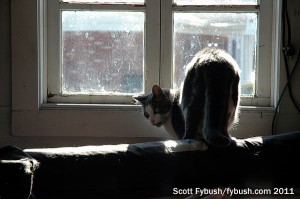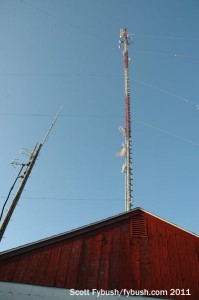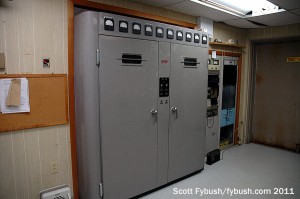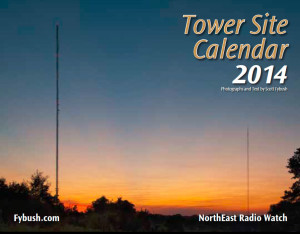NorthEast Radio Watch 12/23 & 12/30/2024: WKIT Lives!
In this week’s issue… WKIT finds a buyer - Eskin out at WIP - Staff shifts in Utica - CRTC approves Bell divestitures
Text and photos by SCOTT FYBUSH
One of America’s best-kept scenic secrets is New York’s Finger Lakes region. Unless you live up here, you probably don’t know just how beautiful the rolling hills and many lakes between Syracuse and Rochester can be, especially in the autumn.


Up here in Rochester, though, your editor takes every opportunity he can to make the hour-long drive down into the heart of the Finger Lakes – especially if there are radio visits involved.
In October 2011, we had the chance to stop in and get some inside peeks at some facilities we’d been seeing from the outside in many decades of traveling the Finger Lakes, including one of the last of the small-town stations that used to dot the region.
Dundee hugs the western shore of Seneca Lake, 20 minutes north of the racing town of Watkins Glen and half an hour or so south of the commercial center of Geneva at the lake’s northern tip. Since 1956, Dundee has been home to WFLR (1570), and since 1968 WFLR has had an FM partner.
WFLR’s studios are in a small old house on Main Street, a block south of the village’s compact business district. It’s a simple layout: some offices right in front, leading into a rack room that faces a pair of studios, one for news and one serving as the main air studio. There’s a production room and some storage space in back – and that’s the domain of the official station cat, who’s named (what else?) “Wiffler”!
WFLR’s transmitter sits on a hill along Pre-Emption Road, off Route 14A northwest of the village. When we stopped by in 2011, WFLR had recently completed a big FM transition: its former class A FM signal, WFLR-FM (95.9), had been moved 20 miles or so to the east into the Ithaca market, becoming top-40 WFIZ (95.5 Odessa). WFLR retained an FM presence by way of a new high-powered translator, W245BL (96.9), operating from right here at the old FM site. That’s an Omnitronix transmitter (since replaced) that was powering AM 1570’s kilowatt of daytime power, backed up by a venerable RCA MX-series AM transmitter tucked into the corner. The old Gates FM transmitter from 95.9 was still here but silent; 96.9 comes from a little Armstrong transmitter tucked into the rack next to the Gates.
The former WFLR-FM, now WFIZ, operates from a tower on Connecticut Hill, west of Ithaca. That’s a site with a very long broadcast history: there’s been FM up here since the early days of the Rural Radio Network. The old RRN station on 103.7 is now WQNY, part of Saga’s big Ithaca cluster, and it has a new antenna and repainted transmitter building since the last time we featured it here on Site of the Week.
One of the reasons FM did well in Ithaca early on, we suspect, is that Ithaca was a daytime-only AM market for many decades. Its heritage AM signal, WHCU (870), traces its history way back to 1922 and Cornell University’s WEAI. As with so many educational stations back then, the Federal Radio Commission eventually corralled WEAI into a daytime-only operation on 850 kilocycles, a frequency it shared with the Elmira Star-Gazette‘s WESG, By the mid-1930s, the two stations had combined: Cornell held the license but leased it to the newspaper, which ran WESG almost entirely out of Elmira, 35 miles away. A split in 1940 put Cornell back in control of this license under the WHCU calls, while the Star-Gazette went full-time on the new WENY (1200, later 1230) from the former WESG tower in South Elmira.
The “new” WHCU moved to 870 in 1941 but remained a daytimer for four more decades before adding night service in the 1980s. When it did, it needed a separate site for nighttime operation: its day site, east of Ithaca, was in the wrong spot to put a signal over the city while protecting the dominant 870, WWL out of New Orleans.
And so it came to pass that WHCU put up three new towers on Protts Hill in Newfield, off Route 13 to the south of Ithaca. The 1000-watt directional night signal that’s aimed north from there doesn’t come close to matching the reach of the big WHCU 5000-watt non-directional day signal, but it’s better than nothing – especially in recent years, when it’s been accompanied by an FM translator (ironically enough, now on 95.9, the old WFLR-FM channel).




WTKO (1470) signed on in 1956 with 1000 watts, eventually upgrading to full-time status with four towers running 5 kW days/1 kW nights up here on Troy Road, on Ithaca’s South Hill.
WTKO eventually ended up as a sister station to WHCU under Eagle Broadcasting and then Saga. It’s now WNYY, programming progressive talk, and its site up here on the hill has gotten rather more crowded in the last few years as Saga has built out multiple translators to add to its cluster of three Ithaca-market full-power FMs.
Both WHCU and WNYY are now heard on translators up here (95.9 and 97.7, respectively), fed by HD subchannels of WYXL (97.3) and WQNY (103.7); additional subchannels feed separate programming to AAA “The Vine” on 96.7 and top-40 “Hits” on 103.3, plus another translator on 98.7 that relays WQNY’s country format.
There’s one more Saga site in Ithaca to see: when WESG became WHCU in 1940, its transmitter moved from Elmira to a self-supporting tower on Pleasant Hill Road, on Cornell-owned land a few miles east of Ithaca. That site also became home to WHCU-FM when it signed on at 97.3 in 1947, but it had to be abandoned in the early 1970s because it was too close to the Ithaca airport’s flight paths.
So WHCU and WHCU-FM moved just a little bit eastward to the site that they still occupy. What’s now the daytime-only site of WHCU(AM) and the fulltime site of now-WYXL on 97.3 is a prominent sight up here on the hill, just up the road from their old site, which is now the Cornell Observatory – and which still has the concrete footings of the old WHCU tower visible out back.
Thanks to WFLR’s Mike Smith and Saga’s Brian Kerkan for the tours!


The Tower Site Calendar, 2014 edition, is shipping daily, spiral bound, shrink wrapped and best of all, with a convenient hole for hanging!
This year’s gorgeous electronic pinups include the iconic towers of Catalina Island, a combiner system in St. Louis, the twin towers of KNRS in Salt Lake City, a historic rooftop site in Jamestown, New York and many more!
If you want a tower calendar on your wall NOW, you can pick up the current edition for just $5 with your 2014 order!
Click here to order your new calendar!
Then check out our store page for our other great merchandise, including the last-ever FM Atlas, the new NRC AM Log and a model of the KSAN tower.
And don’t miss a big batch of cross-country IDs next Wednesday, over at our sister site, TopHour.com!
Next week: Muncie and New Castle, Indiana, 2011
In this week’s issue… WKIT finds a buyer - Eskin out at WIP - Staff shifts in Utica - CRTC approves Bell divestitures
In this week’s issue… WBUR backs off local talk - EMF's expansion in NY, nationally - Rochester broadcasters honored - Russell finds new PA radio home - Remembering Bruce Stevens - The new calendar's here!
In this week’s issue… Remembering WNY's Palvino, Harris - Will King sell Bangor stations? - Kay moves earlier - New signal on LI - Cumulus cuts hit PA, New England - Frizzell sells in NH
In this week’s issue… Saluting a small-town radio vet - Bell moves CP24 - Scott heads west - Burlington gets Air 1, "Experimental Radio" - Family Life heads down I-86